Up until a decade prior to this article being written, photography was considered as a career option, accomplishable, but, by a few. The primary rationale behind this were the enormous costs levied on procuring the equipment.
However, the coming of the age of smartphones and digital cameras transcended photography to a whole new level. These days, all that it takes to master the art of photography, is to grab your camera or smartphone, position your favorite lens on it, and start clicking away at the object of your fascination.
Despite this simplicity accompanying photography, a lot of veterans in the field would zestfully argue that the legal aspects of photography are anything but simple. If you have been passionately following the field for a while, you might argue the same, as well. This is because you are legally required to procure the permissions for clicking someone’s photo when they are in their private space.
Failure to do so could come back to inflict serious ramifications on your career as well as your reputation.
Contents
Photo Release Forms
The aspect of photography, in-charge of sanctioning or procuring the required permissions are Photo Release Forms. These photo release forms constitute to be an indispensable part of photography. These forms, provide first-hand protection to the photographer’s rights, in the event of an incorrect violation of privacy accusation.
People expect the right to a certain level of privacy. Not only has this been ruled by the Supreme Court, but it also constitutes as an unwritten rule within the minds of people. As an individual, you have the right to be left alone. When you are at your personal space, it is reasonably expected that you are left alone. Your country provides this right to you.
However, when you’re at a public place, such as a park, you forfeit at least some part of this right. This is because photographers are allowed to click pictures of any person or property that lies within the public domain. A photographer’s right protects him when he is photographing someone or something at a park. This is considered perfectly alright.
However, what they are prohibited from doing, is clicking pictures of a person or a property that is present in someone else’s private sphere. This could include the snapping someone’s pictures when they are their private residence or perhaps, at their workspace. Apart from this, it is also illegal to encamp and click photos of a private residence. This is primarily due to the fact that these photos act as a breach of privacy.
Therefore, in the simplest of terms, a photo release form serves two purposes.
- First of all, it establishes a contract in stone, between the photographer and the client. This contract grants him with the permissions required to publish the images.
- Second, it protects the photographer in the event of an undue and incorrect accusation.
The Structure of A Photo Release Form
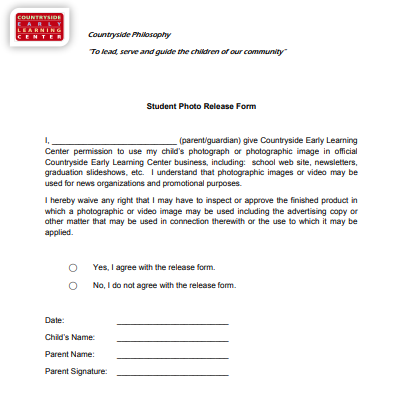
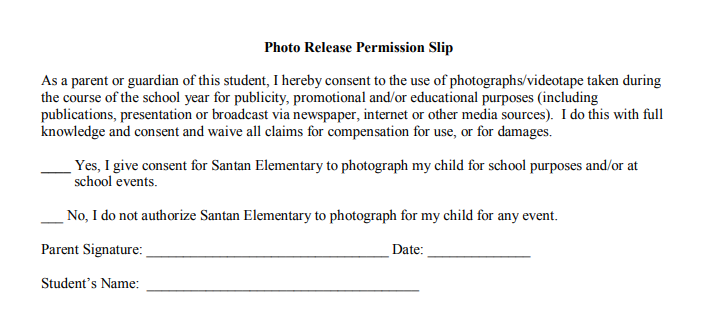
Any typical photo release form contains five different sections:
- The Photographer’s Organization – This section serves as the heading of the photo release form. It depicts either the name of the organization with which the photographer is affiliated or the name of the photographer’s self-employed business.
- The Photographer’s Details – This section houses the complete details of the photographer, primary of which include the name, address, contact number and the e-mail address of the photographer.
- The Legal Statement – The legal statement renders the permissions and rights that are being provided by the client to the photographer, in a written format.
- Details of the Client – Next to the legal statement, the specifics of the client are specified. These details essentially contain client details such as the name, address, contact number, and the email address of the client. Provision of the client’s email address is completed optional and completely depends on the client’s choice.
- The Client’s Signature – Following his details, the client has to provide his signature. This signature affirms the terms and conditions that have been provided in the form. Also, with the help of the signature, the client asserts that the details provided him are correct.
- The Photographer’s Signature – Finally, the photo release form provides a section for the photographer’s signature.
Filling Up A Photo Release Form
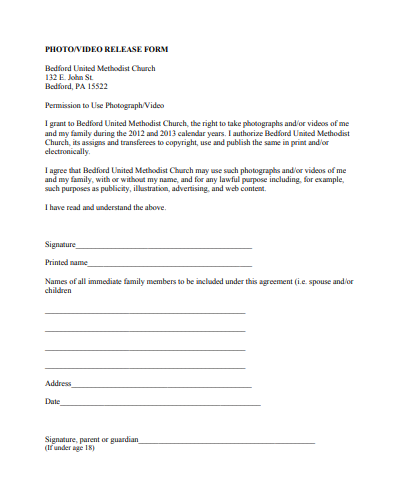
Normally, in order to be allowed to use your client’s pictures for business purposes, you need to fill up and submit the photo release form. Filling up a photo release form is not complicated, albeit it is a long and arduous one. Given below are the numerous steps involved in filling up a typical photo release form.
- While filling up a photo release form, the first aspect that y5ou will come across is your client’s name. While entering your client’s form, you should make it a point to enter the complete name of your client, i.e. the first name as well as the last. Make sure that the name is clearly visible and that there are no errors that lower the visibility.
- The next element is that you will come across is that of the photographer’s name. Follow the similar rules as the ones which you followed while filling up your client’s name.
- Moving further down on the photo release form, bring into light the spaces provided to enter the photographer’s details. A few of the mandatory sets of information that are highly essential are:
- The photographer’s complete address
- Details regarding the city, state of residence, country and the postal code
- The photographer’s date of birth
Finally, after you enter these details, you encounter the space for entering the photographer’s signature. The signature is the most important aspect amongst all these details. For it is with the help of the signature that the photographer affirms the information entered by him and deems it to be true. Failing to enter your correct signature could lead your photo release form to be regarded worthless.
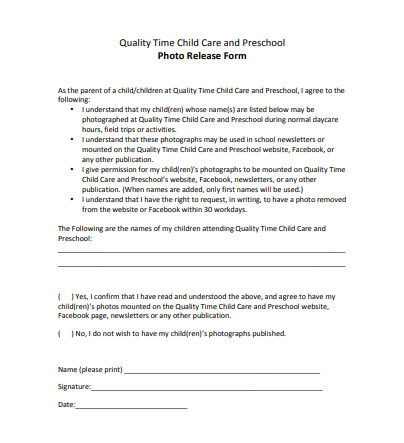
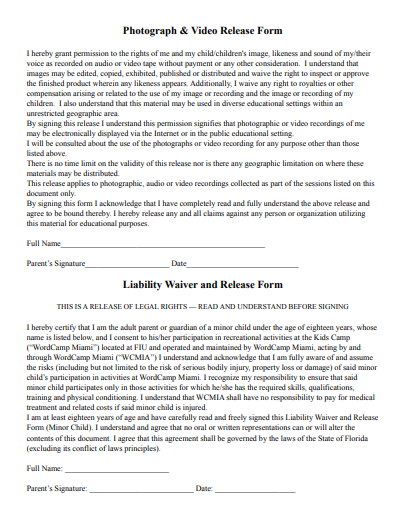
7. Next on the photo release form is a section to house the Client or Model Information. Usually, whenever a photo release form refers to a model, it usually refers to the client who is present in the picture. Similar to the Photographer’s Information, this section also asks for several pieces of information such as the address, city, contact number etc.
An additional section, present in the Client Information that is absent from the Photographer’s Information section, is the Description or the Scene Description. Usually, this is an optional section and you may choose to skip it if you want. Despite this, if you want to enter some information, a single line or two will suffice.
8. In a lot of photo release forms, there is an additional section known as Model Ethnicity. This, again, is an optional section. The Model Ethnicity section is tasked with collecting details regarding the social group or nationality that your model or client belongs to. There are various options provided beneath this subheading such as Asian, European, African-American etc. The various ethnicities that are provided in a checklist format. All that you need to do is check the checklist containing the model’s ethnicity.
9.Finally, you may also have another optional section present at the end section of your photo release form. This section is known as Witness Information. Similar to the Model Ethnicity section, the Witness Information section may or may not be present, depending on the organization that supplies the Photo Release Forms.
In the event that it is present, all that you need to know is that this section keeps a track on any witnesses who might have presided over your photoshoot. There are only three witness details are required to be entered under this section. They include the name of the witness, his/her signature and the date on which the form was signed by the witness.
Sample Photo Release Form Templates
Creating photo release forms are not particularly difficult. Be that as it may, their lengthy and arduous nature prohibit us from labeling them as a pleasurable task. This, however, should not give you cause to fret.
Given below are a few sample photo release form templates which you can implement in your day-to-day work processes.
Photography Copyright Release Forms
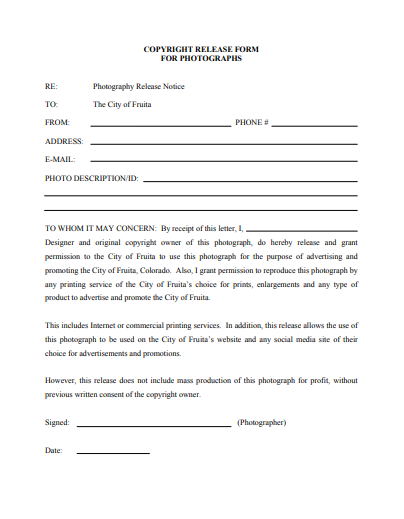
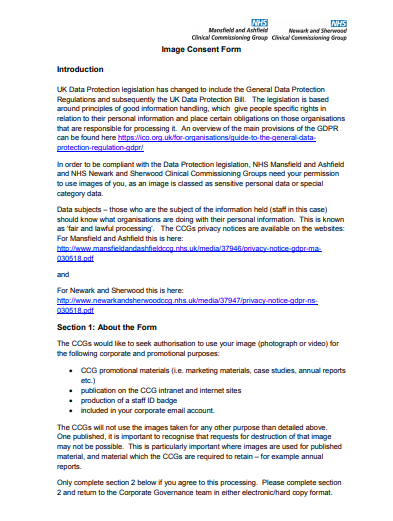
Photography Copyright Release Forms are one of the most basic or generic release forms that are available. These forms are generic in the sense that they can be used for a wide range of applications. In fact, a lot of organizations often employ these release forms to create a release form that suits their business by focusing on a set of specialized features.
These Release Forms can originate either from the end of the photographer and make their way to the client, who might be using the pictures. However, creating a release form that performs the vice-versa is completely possible and legal.
Being in its most basic state, it is understandable that the form provided below may not quench all your needs. In such an event, you can modify it to suit your individual needs. On the other hand, if you wish to, you can use the form in the manner in which it is given.
Photo Release Consent Form
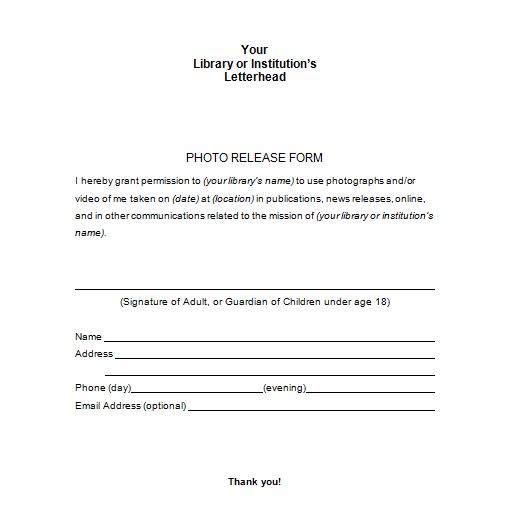
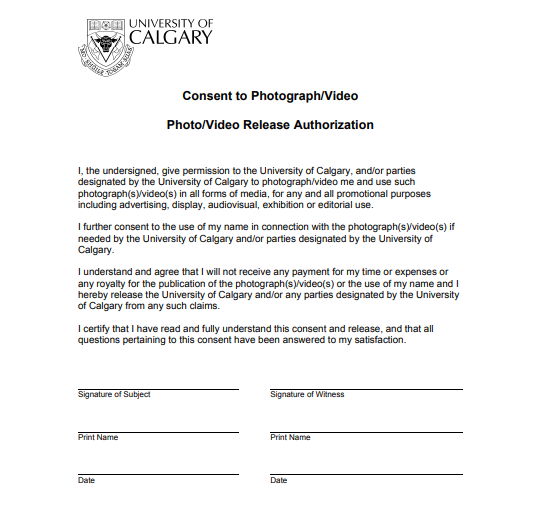
Also known as Photo Release Forms, Photo Release Consent Forms allow the photographer to obtain the required permissions from a particular client or model. The permissions allow the photographer to legally use the photographs for their personal as well as commercial use.
While signing the consent forms, the client or the model can choose to give the rights away on a pro bono basis or they can charge some fees or royalty for them. In case the client charges some fees, the ownership rights do not get transferred unless both the payment is finalized.
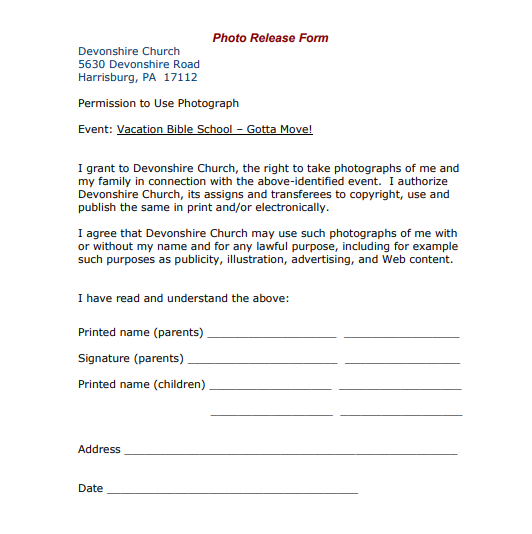
Model Photo Release Forms
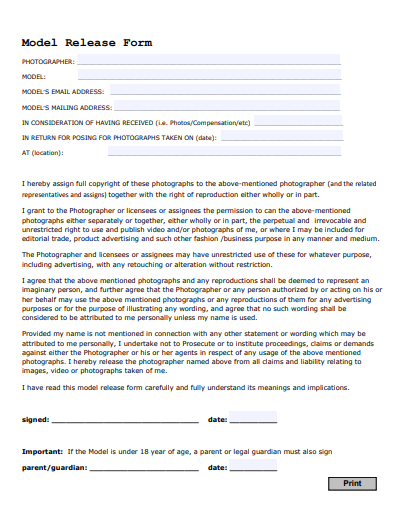
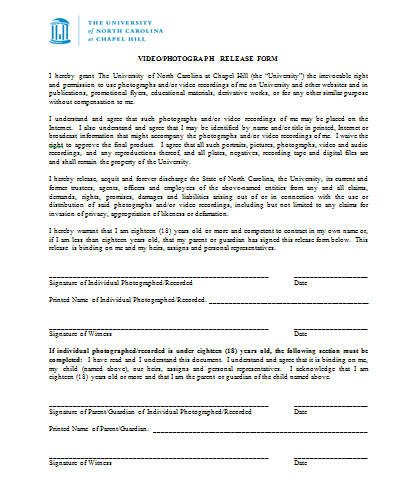
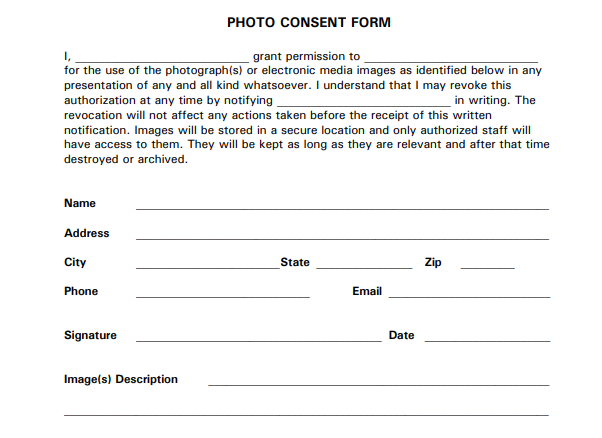
Similar to Photo Release Forms, a Model Release Form is a contract that used to protect you from any potential liabilities from the model who you are photographing. In most cases, a model photo release form is a document that takes into account all the terms which come along with the photos that are taken of another party.
The template for the Model Photo Release Forms is highly similar to the Photo Release Consent Forms as provided prior. You can use the template given above and suit it according to your needs.
Photo Release Form for Minors
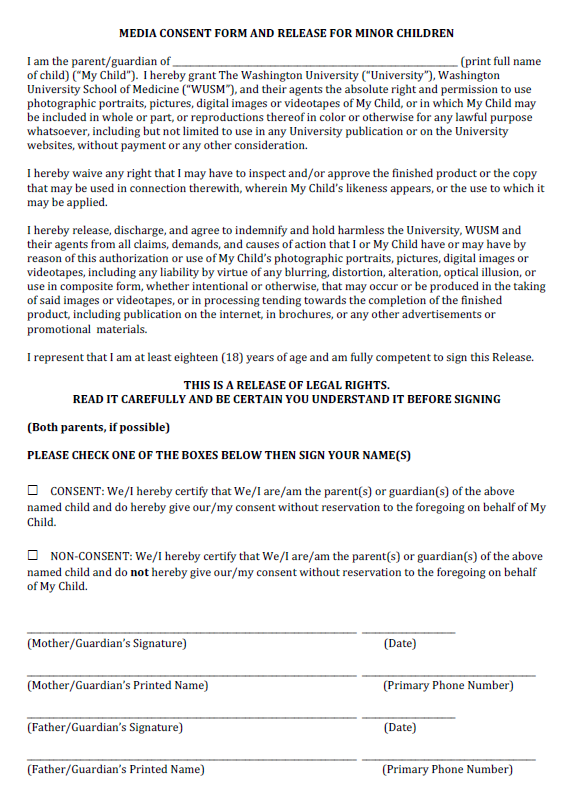
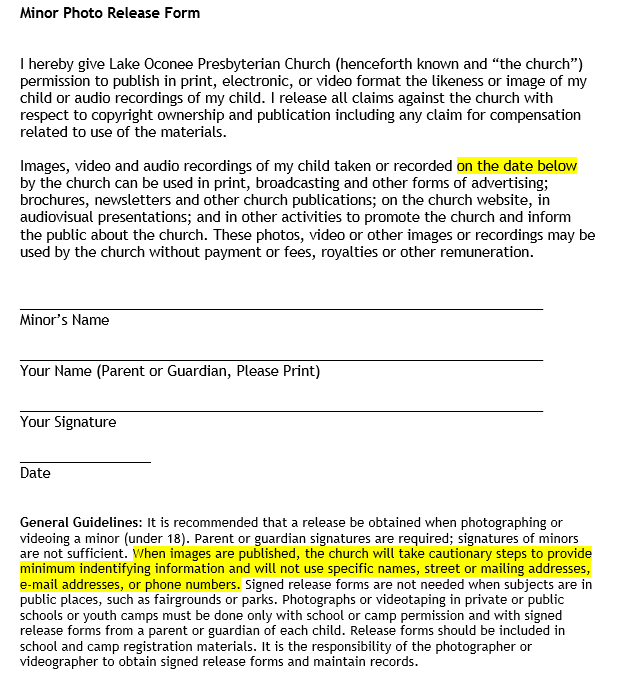
A Minor Photo Release Form is a form that facilitates photographers with the authorization required for clicking photos of minors. These are special forms in which, instead of the children agreeing and affirming to the terms and conditions of the Release Forms, it is the parents or the guardians who perform the same.
Given below is a template for a Minor Photo Release Form that could be used for your business purposes.
Photo Release Form for Social Media
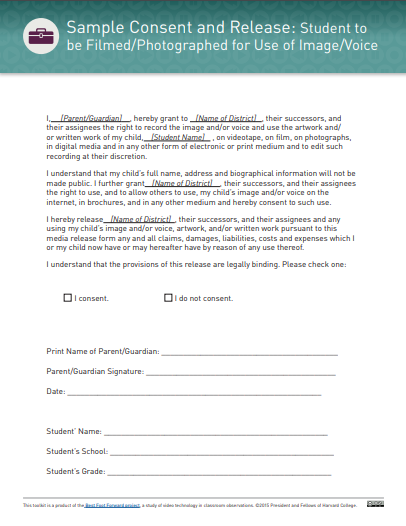
With the advent of social media, it has become easier for amateur photographers as well as professionals to showcase their work and present their creations to the world. By showcasing their work, the photographers are able to provide a sandbox where the photographers are able to experiment creatively.
However, the social media aspect of photography has stressed the aspect of privacy as well. Due to this, photography organizations lay stress on providing photo release forms to their clients while uploading their photos on social media. By granting organizations with these permissions, organizations are able to post images on social media without worrying about any liabilities that may befall on them.
Typically, Social Media Photo Release Forms are highly similar to Photo Release Consent Forms. If you want you can easily use the template given above for Photo Release Consent Forms and suit it according to your needs.
Employee Photo Release Forms
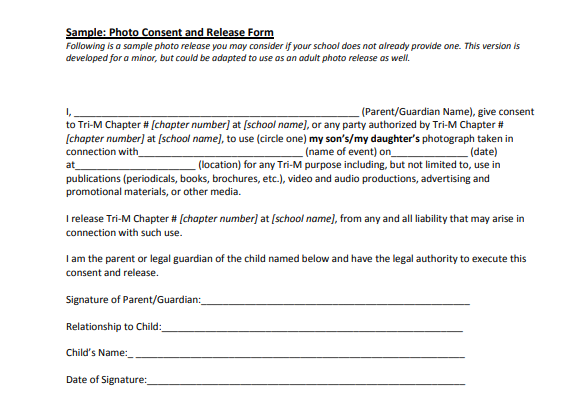
Using pictures or videos of your employees as an aspect to display your company’s personality is probably one of the best ideas that you can integrate into your work processes. If your employee is at a public place, you can, unhesitatingly, take their photos as long as it is not being used to promote a product, service, or cause.
However, if you’re using their photos for some commercial purpose, such as some online printed material, advertisements or such, you should get consent from your employees. Not only does asking your employees for consent good for legal purposes, but it also shows them respect and promotes a positive attitude regarding the employee-employer relationship.
Given below, is a sample employee photo release form that you could use to get the consent from your employees.
Photography Release Laws in The U.S.A
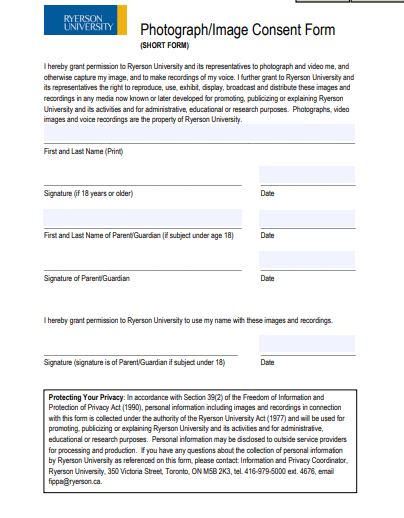
Before you can begin to start drafting a Photo Release Form for your client or model, it is high significance that you consult the laws that are prevalent in your country. Being aware of these laws will provide you with additional clarity while drafting your individual photo release forms. The laws applicable in the U.S.A. are given below:
Laws concerning photography in public places:
- It is completely legal to photograph or videotape anything or anyone while they are on public property. As long as photography or videotaping is performed within reasonable community standards, there are no laws which prohibit you from performing your art.
- Clicking photographs or videotaping aspects whilst you are on a tourist attraction, be it a public or private attraction, is not considered to be illegal as long as it is not explicitly predefined.
Laws concerning photography on private properties:
- Performing photography on private property is generally prohibited unless the photographer and owner stipulate a photo release form allowing them to perform their photography.
- Performing photography on private properties, such as malls, are generally allowed unless explicitly prohibited. In some cases, the owner of these establishments may ask the photographer to stop their photography or even ask them to leave.
- Private places such as hospital and healthcare facilities do not permit filming.
Internationally, countries perform their photography according to the laws mentioned above. In case you want detailed information on the laws, you should thoroughly check for the laws that persist in your region.
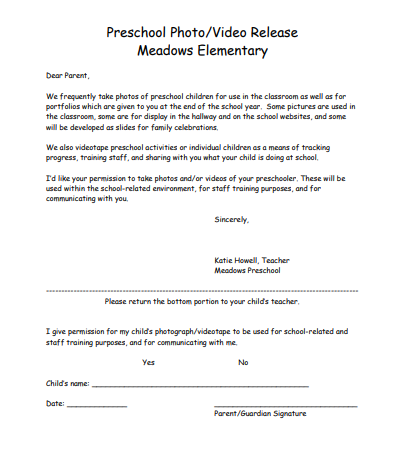
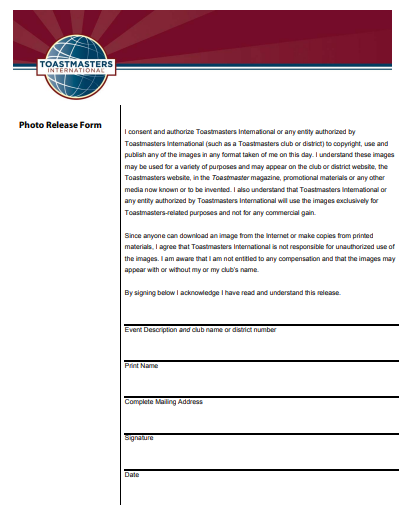
Q&A’s
Q1. What is a Photo Release Form?
A1. In simple terms, a Photo Release Form is a legal document that is used by two parties. With the help of a Photo Release Form, the first party allows or consents the second party to use his or her image in a particular publication. The Photo Release Form is brought into play when the first party signs the Photo Release Form and gives up any claims in regards to the publication of the images.
Q2. When and why do you need a Photo Release Form?
A2. A Photo Release Form serves as a highly useful tool for photographer and photography organizations. These forms are required in two cases:
- First, these forms are used when the photographer or the client wants the required permissions from the other, to publish the images. With the help of the forms, either party gets the requires permissions.
- Secondly, the forms protect either of the parties from any undue accusation that could potentially rise against them in the future.
Q3. What is a Copyright Release Form?
A3. A Copyright Release Form is another legal document that is drafted by the owner of a particular copyright. With the help of these forms, a person or organization can receive the permissions required to make copies of a copyrighted work.
Most of the times, photographers like to own the copyright of their work. With the help of a copyright release form, you can receive the permissions to legally use their work.
Q4. Do you need permission to use a photo of someone?
A4. While using pictures of someone, there are two fundamental aspects which you need to keep in mind. These aspects refer to whether you clicked pictures on a private or on public property. If you clicked those pictures on public property, such as a park, then, in most cases, you wouldn’t need to procure the permissions.
However, if you clicked someone’s photo while they were in their private space, chances are that you would need some permissions to upload their photos.
Q5. Do you need a Model Release for Street Photography?
A5. The street is a public space. Therefore, you wouldn’t necessarily need a Model Release while photographing a public location. However, most photography veterans would say it is better to be safe than sorry. Therefore, you should procure a Model Release in any case.
Q6. Do you need a Model Release for event photography?
A6. In the case of an event, a model release is usually not required. This is because an event is usually performed at a public place and nobody has the right to expect privacy at such an event. However, if you want to be completely sure, you should certainly consult some legal expert.
The photo release form also referred to as photo copyright form or photo consent form, is document stating the contract between the client or model and the photographer
giving the permission to print hard copies of the photos. The photos could be of anything like headshots, family photos, potraits, wedding photos etc. In basic terms,
photo release forms secure legal legal permission between the photographer and the client, subject, and the owner of the something in the photograph in order to
publish images of people and property.
Whether photography is your career or just a hobby, it is important to know about the legal aspects as well i.e. Photo Release Form. Otherwise, you will find yourself
in trouble. A photographer needs photo release form when the photographs of yours are used by others. For ex; If anybody wants to print the images, they need your
written permission which can be done by a photo release form. To make it understand even in a easier way, just put three questions to your client and if the answer is
‘YES’ then that is the situation where you need a photo release form.
1) Is the photograph for commercial purposes?
2) Can people recognise the subject in the image?
3) Is the photograph going to be used for advertisement?
There are many kinds of photo release forms. Each photo release form has its own specific purpose and importance, and now we’ll go through some of them.
1) Print Release Form
2) Minor Release Form
3) Model Release Form
4) Property Release Form
5) Copyright Release Form
6) Building Release Form
Hire a intellectual property lawyer to draft your required type of photo release form to ensure it is legally sound as all online templates are not legally binding.
Make sure your document is legible
Prep your paperwork ahead of time
A release form should be a contract format as the law states that the client needs enough time to review the document and negotiate the terms.
Be specific while personalizing your own release forms and never leave anything open-ended or up for interpretation.
Remember to give your client a copy of the document!
A simple photo release form is a basically a contract form that protects the interests and the rights of both parties. It helps both parties, and safeguards them
against unwanted actions. It should be short and sweet and contain the photographed person’s name, phone number, address, and witness. However, there are much longer
versions oftenly used for important and commercial purpose.